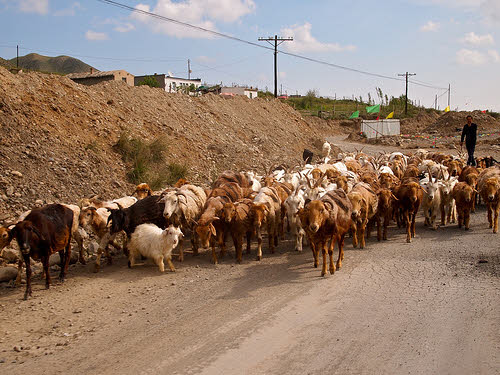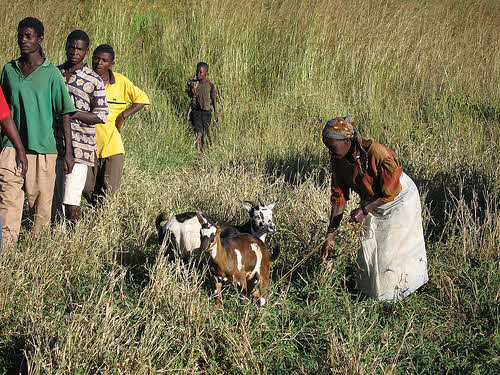The African Dust Bowl
As bad as Asia’s dust storms are, the largest source of dust in the atmosphere on a global scale is Africa. Dust has long traveled out of Africa’s deserts and drylands, which make up two thirds of the continent’s land area; in fact, dust blowing out of Chad’s Bodélé Depression is thought to help fertilize the lush Amazon rainforest. Nearly 75 percent of Africa’s drylands are degraded. With land suffering the double whammy of drought and overuse, dust carried out of West Africa has increased over the last 40 years. Studies suggest that the larger influx of African dust may even be teaming up with rising ocean temperatures to damage Caribbean coral reefs.
In the Sahelian zone south of the Sahara the squeeze is on, with fast-growing populations trying to eke out a living by farming or grazing herds on ever less productive land. Desertification is particularly acute in Burkina Faso, Chad, and Niger, as well as in Nigeria, Africa’s most populous country, where an estimated 868,000 acres are lost to desert each year. Conflicts over land between herders (largely Muslim) and farmers (largely Christian) are legion, with both groups exacerbating erosion. Nigerian pastoralists, largely in the country’s north, have dramatically expanded their herds, putting additional pressure on soils already vulnerable because of erratic rainfall. In 1990, Nigeria had 14 million cattle, 12 million sheep, and 23 million goats. By 2010, cattle populations had climbed just slightly to 17 million, but the number of sheep tripled to 36 million, and goats jumped to 56 million.
Both Africa and China have launched ambitious initiatives to halt the spread of deserts with Great Green Walls of trees. Political leaders—including former Nigerian President Olusegun Obasanjo (an early champion of the African Wall) and Abdoulaye Wade, former President of Senegal—tend to favor such large symbolic projects. Indeed in the throes of the U.S. Dust Bowl, President Franklin D. Roosevelt was similarly taken with the idea of a giant shelterbelt. But as happened in the United States, desert containment plans in the Sahel and China have broadened in scope beyond basic tree belts to encompass more holistic land management and poverty alleviation activities. The limited success at holding back the sands in China thus far, where since the early 1980s an estimated 40 billion trees have been planted (although far fewer have survived), confirms that stopping desertification involves much more than planting trees.
Climate change is complicating the matter even further. Large parts of the planet are trending toward dryness, with a marked increase in aridity since the 1970s, when global temperatures started to climb. As the Earth heats up further, droughts are projected to become even more pronounced. A rapid reduction in greenhouse gas emissions to prevent runaway global warming, along with a slowdown in the growth of both human and livestock populations to reduce pressure on the land, are what it will take to increase our chances of leaving dust bowls to history.
Janet Larsen is the Director of Research for the Earth Policy Institute.
Copyright © 2012 Earth Policy Institute
Image credits: Remko Tanis via photopin cc; khym54 via photopin cc



Joe
Another issue hitting world grain supplies is loss of fossil water (water in underground strata that is not recharged) that has been harvested from underground supplies for instance Saudi Arabia used to grow alot of grain and now so much water has been pumped that the country will within 10 years at the most be growing almost no grains. Same is true in Yemen and parts of Iraq and also over a hundred million people in India and China are in areas where underground supplies of water is dwindling to vey low levels. In the US major underground aquifers in the plains states and in the central valley of CA are also being drawn down and in conjuction with potentially sever droughts hitting again through this year this will mean the 400 million bushel per year that the US grows of grains that the entire world depends on is at severe risk if rainfall and snowfall does not recover. If the Rockies does not recover as far as snowfall- water supplies in the Colorado River are at risk for agricultural uses and urban areas in many states. Time will tell by the fallof 2013 as to how deep this issue is with water supplies and grain supplies and resultant spread of hunger and nations stability resulting in political upheaval- all of this is interlinked- global warming, water availability and use, grain supplies, hunger, costs of food impacting in many nations including the US, and international nation stabilities,
Jeff McIntire-Strasburg
Thanks for your input, Joe! The folks at EPI have covered this issue, also (and largely confirmed the challenges you’ve laid out):
https://sustainablog.org/2011/07/water-shortages-grain-harvest/
https://sustainablog.org/2011/08/environmental-refugees/